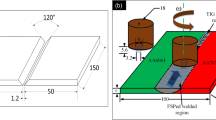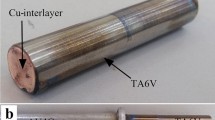Abstract
In this study, a pair of welds was made in austenitic stainless steel AISI 304L and the novel twinning-induced plasticity (TWIP) steel microalloyed with titanium. Microstructural characterization and mechanical assessment were conducted with the aim to compare the weldability of both materials. The weld joints were performed in two passes by means of the autogenous gas tungsten arc welding (GTAW) process. The operating parameters were defined with the aid of penetration depth predictions carried out by a finite element (FE) numerical model. The results indicated that the weldability of TWIP-Ti steel compared to that of the AISI 304L steel had some advantages as the lower extension of the heat affected zone (HAZ) and a lower mechanical properties loss with respect to the base material. The ferritic solidification mode towards the outer of the FZ in the AISI 304L steel avoided hot cracking in the HAZ. Conversely, the HAZ of TWIP-Ti steel did not present hot cracking despite the austenitic solidification mode. The higher thermal diffusivity of the TWIP-Ti steel had a positive effect in the HAZ conditions improvement, which in turn was correlated with the welding cooling rates and microstructural aspects through the FEM model.
Similar content being viewed by others
References
De Cooman BC, Kwon O, Chin KG (2012) State-of-the-knowledge on TWIP steel. Mater Sci Technol 28(5):513–527
Frommeyer G, Brüx U, Neumann P (2003) Supra-ductile and high-strength manganese-TRIP/TWIP steels for high energy absorption purposes. ISIJ Int 43(3):438–446
Wang T, Zhang M, Xiong W, Liu R, Shi W, Li L (2015) Microstructure and tensile properties of the laser welded TWIP steel and the deformation behavior of the fusion zone. Mater Des 83:103–111
Rossini M, Spena PR, Cortese L, Matteis P, Firrao D (2015) Investigation on dissimilar laser welding of advanced high strength steel sheets for the automotive industry. Mat Sci Eng A 628:288–296
Çam G, Koçak M (1998) Progress in joining of advanced materials: part I: solid state joining, fusion joining, and joining of intermetallics. Sci Technol Weld Join 3(3):105–126
Çam G, Koçak M, Dos Santos JF (1999) Developments in laser welding of metallic materials and characterization of the joints. Weld World 43(2):13–26
Dos Santos J, Çam G, Torster F, Insfran A, Riekehr S, Ventzke V, Koçak M (2000) Properties of power beam welded steels, Al- and Ti-alloys: significance of strength mismatch. Weld World 44(6):42–64
Razmpoosh MH, Shamanian M, Esmailzadeh M (2015) The microstructural evolution and mechanical properties of resistance spot welded Fe–31Mn–3Al–3Si TWIP steel. Mater Des 67:571–576
Tutar M, Aydin H, Bayram A (2017) Effect of weld current on the microstructure and mechanical properties of a resistance spot-welded TWIP steel sheet. Metals 7(12):519
Ramesh S (2012) Applied welding engineering: processes, codes and standards. Butterworth-Heinemann, USA
Mujica L, Weber S, Hunold G, Theisen W (2011) Development and characterization of novel corrosion resistant TWIP steels. Steel Res Int 82(1):26–31
Yoo J, Han K, Park Y, Choi J, Lee C (2014) Evaluation of solidification cracking susceptibility of Fe–18Mn–0·6C steel welds. Sci Technol Weld Join 19(6):514–520
Májlinger K, Kalácska E, Spena P (2016) Gas metal arc welding of dissimilar AHSS sheets. Mater Des 109:615–621
Roncery LM, Weber S, Theisen W (2012) Welding of twinning-induced plasticity steels. Scripta Mater 66(12):997–1001
Yoo J, Kim B, Park Y, Lee C (2015) Microstructural evolution and solidification cracking susceptibility of Fe–18Mn–0.6 C–xAl steel welds. J Mater Sci 50(1):279–286
Ma LL, Wei YH, Hou LF, Yan B (2014) Microstructure and mechanical properties of TWIP steel joints. J Iron Steel Res Int 21(8):749–756
Kumar S, Shahi AS (2016) Studies on metallurgical and impact toughness behavior of variably sensitized weld metal and heat affected zone of AISI 304L welds. Mater Des 89:399–412
Ogawa T, Tsunetomi E (1982) Hot cracking susceptibility of austenitic stainless steels. Weld J 61(3):82
Çam G, Erim S, Yeni Ç, Koçak M (1999) Determination of mechanical and fracture properties of laser beam welded steel joints. Weld J 78(6):193–201
Çam G, Yeni Ç, Erim S, Ventzke V, Koçak M (1998) Investigation into properties of laser welded similar and dissimilar steel joints. Sci Technol Weld Join 3(4):177–189
García-García V, Reyes-Calderón F, Camacho-Arriaga JC (2016) Optimization of experimental temperature measurement in GTAW process by means of DoE technique and computational modeling. Measurement 88:297–309
ASTM (2010) Standard Test Methods for Determining Average Grain Size, in ASTM Standard E112. ASTM International, West Conshohocken. https://doi.org/10.1520/E0112-10
Goldak J, Chakravarti A, Bibby M (1984) A new finite element model for welding heat sources. Metall Mater Trans B Process Metall Mater Process Sci 15:299–305
McDill JM, Goldak JA, Oddy AS, Bibby MJ (1987) Isoparametric quadrilaterals and hexahedrons for mesh-grading algorithms. Commun Appl Numer M 3(2):155–163
Saha DC, Park Y (2013) Weldability and liquation cracking characteristics on resistance-spot-welded high-Mn austenitic steel. In Trends in Welding Research 2012: Proceedings of the 9th International Conference (p. 330), ASM International
Mujica L, Weber S, Thomy C, Vollertsen F (2009) Microstructure and mechanical properties of laser welded austenitic high manganese steels. Sci Technol Weld Join 14(6):517–522
Korinko PS, Malene SH (2001) Considerations for the weldability of types 304L and 316L stainless steel. Pract Fail Anal 1(4):61–68
Mirshekari GR, Tavakoli E, Atapour M, Sadeghian B (2014) Microstructure and corrosion behavior of multipass gas tungsten arc welded 304L stainless steel. Mater Des 55:905–911
Lee DJ, Jung KH, Sung JH, Kim YH, Lee KH, Park JU, Lee HW (2009) Pitting corrosion behavior on crack property in AISI 304L weld metals with varying Cr/Ni equivalent ratio. Mater Des 30(8):3269–3273
Lee C, Yoo J, Kim S, Park Y, Choi J (2011) Characteristics of the hot cracking and segregation behaviour in the high manganese steels welds, in: Proceedings of the 1st International Conference on High Manganese Steels, Seoul
Kumar S, Shahi AS (2011) Effect of heat input on the microstructure and mechanical properties of gas tungsten arc welded AISI 304 stainless steel joints. Mater Design 32(6):3617–3623
Yan J, Gao M, Zeng X (2010) Study on microstructure and mechanical properties of 304 stainless steel joints by TIG, laser and laser-TIG hybrid welding. Opt Laser Eng 48(4):512–517
Bergman TL, Incropera FP, DeWitt DP, Lavine AS (2011) Fundamentals of heat and mass transfer. Wiley, USA
Funding
This study is supported by the National Council on Science and Technology (Consejo Nacional de Ciencia y Tecnología-México) during the project CB-2012-01-0177572. The present research project was also supported by the Coordinación de la Investigación Científica-UMSNH (México) (CIC-1.8). Víctor García’s studies were sponsored by the National Council on Science and Technology (Consejo Nacional de Ciencia y Tecnología-México), N.B. [577720].
Author information
Authors and Affiliations
Corresponding author
Rights and permissions
About this article
Cite this article
García-García, V., Mejía, I. & Reyes-Calderón, F. Comparative study on weldability of Ti-containing TWIP and AISI 304L austenitic steels through the autogenous-GTAW process. Int J Adv Manuf Technol 98, 2365–2376 (2018). https://doi.org/10.1007/s00170-018-2392-0
Received:
Accepted:
Published:
Issue Date:
DOI: https://doi.org/10.1007/s00170-018-2392-0




